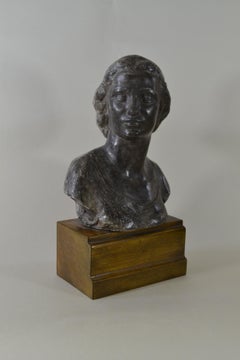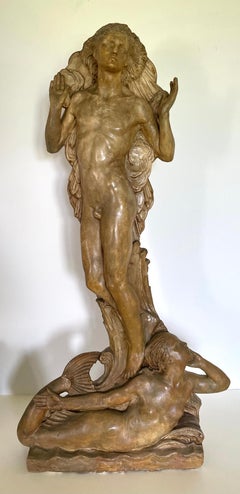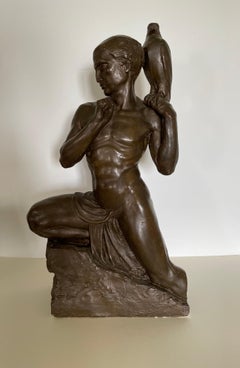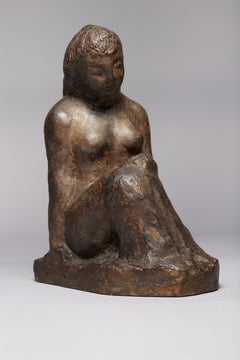Richard Garbe Figurative Sculptures
to
1
1
1
Overall Width
to
Overall Height
to
3
1
1
2
3
3
3
2
1
1
1
1
3
3
125
100
100
89
3
Artist: Richard Garbe
Alfreda, The Artist's Daughter - British 1950s plaster bust by Richard Garbe
By Richard Garbe
Located in London, GB
RICHARD LOUIS GARBE, RA
(1876-1957)
Alfreda, The Artist’s Daughter
Signed and dated 1956
Plaster with patinated surface on a wooden base
30 cm., 11 ¾ in. high
Provenance:
Gifted ...
Category
1950s Realist Richard Garbe Figurative Sculptures
Materials
Plaster
Richard Garbe - Helios - Early 20th Century British patinated plaster sculpture
By Richard Garbe
Located in London, GB
RICHARD LOUIS GARBE, RA
(1876-1957)
Helios
Signed and dated 1929
Plaster with patinated surface
86 cm., 33 ¾ in. high
Garbe was born in Dalston, London, the son of Gustave Garbe,...
Category
Early 20th Century Art Deco Richard Garbe Figurative Sculptures
Materials
Plaster
The Falconer, Art Deco British Plaster Sculpture by Richard Garbe RA
By Richard Garbe
Located in London, GB
RICHARD GARBE, RA
(1876-1957)
The Falconer
Signed and dated on the reverse: Richard Garbe, ARA / 1932
Patinated plaster
49.5 cm., 19 ½ in. high
Proven...
Category
1930s Art Deco Richard Garbe Figurative Sculptures
Materials
Plaster
Related Items
Late 19th Century Pair of Bronze Atlas Sculptures with Globe & Armillary Sphere
Located in Fredericksburg, VA
This pair of bronze sculptures of Atlas with Globe & Armillary Sphere are of high cast quality. Pairs have sold for over 700,000 Euro. Their condition is excellent for age and has ve...
Category
Early 20th Century Art Deco Richard Garbe Figurative Sculptures
Materials
Bronze
$395,000
H 89 in W 22 in
Seated Nude Woman Sculpture, Early 20th Century
By William Zorach
Located in Beachwood, OH
William Zorach (American, 1887-1966)
Seated Woman
Painted plaster
Inscribed underside "V"
12.5 x 9 x 5 inches
Provenance: The Tatti Family Collection
Bill Zorach was born in Lithuan...
Category
Early 20th Century Richard Garbe Figurative Sculptures
Materials
Plaster
"Pioneer Family" WPA American Modernism Plaster Maquette Realism 20th Century
By William Zorach
Located in New York, NY
"Pioneer Family," 23 1/2 x 16 1/4 x 10 3/4 inPlaster. c. 1927. Unsigned. Realism
The Smithsonian has a cast of this sculpture in its collection. Pictured on the cover of “The Sculpt...
Category
1920s American Modern Richard Garbe Figurative Sculptures
Materials
Plaster
$31,200 Sale Price
20% Off
H 24 in W 17 in D 11 in
Finely rendered Equestrian Model Sculpture
Located in Greenwich, CT
a very fine Model Sculpture of a standing horse , finely rendered in patinated plaster, signed ‘MMM’ and dated 30 , w. rich burnished patina.
Its quality and elegance are reminiscent...
Category
Early 20th Century Richard Garbe Figurative Sculptures
Materials
Plaster
Pair of 19th century scagliola sculptures (Italian Neoclassicism) - Roman figure
Located in Varmo, IT
Pair of scagliola sculptures - Roman figures. Italian manufacture, 19th century.
51 x 26 x h 118 cm (left) - 41 x 28 x h 118 cm (right).
Made entirely of scagliola. Depicting two f...
Category
Early 19th Century Old Masters Richard Garbe Figurative Sculptures
Materials
Plaster
$5,671 Sale Price
20% Off
H 46.46 in W 20.08 in D 10.24 in
Dance of Carthage
By Claire J. R. Colinet
Located in PARIS, FR
Dance of Carthage
by Claire-Jeanne-Roberte COLINET (1880-1950)
A bronze sculpture with gilded patina
Signed on the base " Cl.J.R. Colinet "
Old Per...
Category
1920s Art Deco Richard Garbe Figurative Sculptures
Materials
Bronze
Mid Century Sgraffito, Saltimbanque and the Card Player, Circle of Picasso.
Located in Cotignac, FR
Mid 20th Century sgraffito work on plaster by Jean Pierre de Cayeux. The work is signed and dated on the skirt of the card player, bottom right, and on the stretcher of the chair, bo...
Category
Mid-20th Century Modern Richard Garbe Figurative Sculptures
Materials
Enamel
$1,134 Sale Price
20% Off
H 16.93 in W 12.41 in D 0.6 in
Carved wooden lectern - Eagle. Italy, 19th century
Located in Varmo, IT
Carved wooden lectern - Eagle. Italy, 19th century.
88 x 55 x h 153 cm.
Made entirely of carved wood in the shape of an eagle.
- This item is sold with a certificate of authentic...
Category
Early 19th Century Realist Richard Garbe Figurative Sculptures
Materials
Wood
[Bruce Sargeant (1898-1938)] Statue of an Athlete
By Mark Beard
Located in New York, NY
This artwork is offered by ClampArt, located in New York City.
“Bruce Sargeant is a mythic figure in the modern art movement. He embodies a world that is in many ways lost to us; he...
Category
21st Century and Contemporary Realist Richard Garbe Figurative Sculptures
Materials
Bronze
Deer, Large Patinated Bronze Sculpture
Located in Long Island City, NY
This bronze sculpture of a deer is a realistic rendering of the majestic animal. Deer have been the center of literature and art for many cultures across the world. They have also ...
Category
20th Century Realist Richard Garbe Figurative Sculptures
Materials
Bronze
Anatomical Sculpture of Nude Male "L'Ecorche" after Jean Antoine Houdon
By Jean-Antoine Houdon
Located in Rochester, NY
An anatomical maquette of Houdon's l'Écorche (Flayed Man), after the original completed in 1767 while Houdon was a student in Rome, and the basis for his sculpture of Saint John the ...
Category
20th Century Richard Garbe Figurative Sculptures
Materials
Plaster
$1,385
H 29.75 in W 8 in D 8 in
"Mercury" NYC 1931 Bronze 5th Ave Traffic Light Sculpture American Art Deco WPA
Located in New York, NY
"Mercury" NYC 1931 Bronze 5th Ave Traffic Light Sculpture American Art Deco WPA
In the late 1920s, Joseph Freedlander was asked by the City of New York ...
Category
1930s Art Deco Richard Garbe Figurative Sculptures
Materials
Bronze
$40,000
H 18 in W 9 in D 6 in
Richard Garbe figurative sculptures for sale on 1stDibs.
Find a wide variety of authentic Richard Garbe figurative sculptures available for sale on 1stDibs. You can also browse by medium to find art by Richard Garbe in plaster and more. Much of the original work by this artist or collective was created during the 20th century and is mostly associated with the Art Deco style. Not every interior allows for large Richard Garbe figurative sculptures, so small editions measuring 10 inches across are available. Customers who are interested in this artist might also find the work of Gary Sczerbaniewicz, Pierre Jules Mêne, and Gary Alsum. Richard Garbe figurative sculptures prices can differ depending upon medium, time period and other attributes. On 1stDibs, the price for these items starts at $2,416 and tops out at $7,008, while the average work can sell for $5,097.



